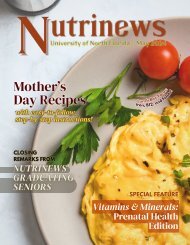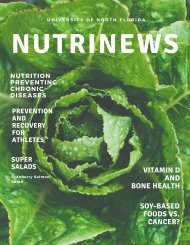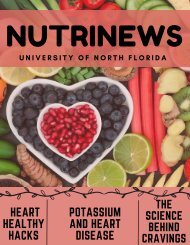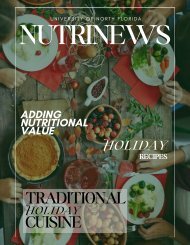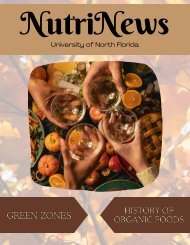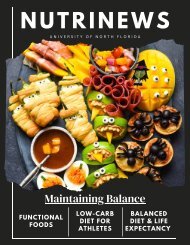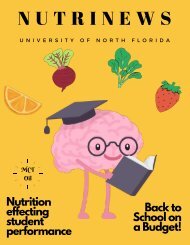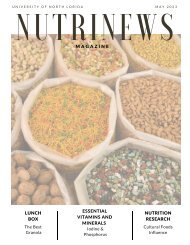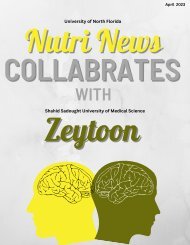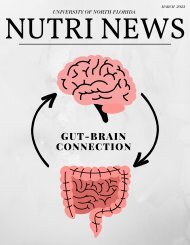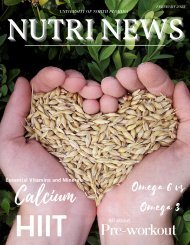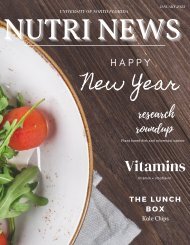April 2024 Issue: Sustainable Nutrition
This month the theme of our issue is Sustainable Nutrition! With Earth day right around the corner, the April issue of NutriNews focuses on sustainable nutrition. There are many ways that we can take steps each day to eat more sustainably. Learn more about hacks for eating sustainably, research on sustainable nutrition, a delicious recipe, and an exciting collaboration with the University of Copenhagen all in this issue of NutriNews!
This month the theme of our issue is Sustainable Nutrition! With Earth day right around the corner, the April issue of NutriNews focuses on sustainable nutrition. There are many ways that we can take steps each day to eat more sustainably. Learn more about hacks for eating sustainably, research on sustainable nutrition, a delicious recipe, and an exciting collaboration with the University of Copenhagen all in this issue of NutriNews!
You also want an ePaper? Increase the reach of your titles
YUMPU automatically turns print PDFs into web optimized ePapers that Google loves.
U N I V E R S I T Y O F N O R T H F L O R I D A<br />
Nutri New s<br />
Tomato<br />
Soup<br />
FRIENDS SHOP FIRST!<br />
PRE-SLEEP<br />
PROTEIN<br />
SUSTAINABLE<br />
FOODS<br />
Collaboration<br />
with the<br />
University of<br />
Copenhagen!
TABLE OF CONTENTS<br />
" E V E R Y D A Y I S A C H A N C E T O B E G I N A G A I N . D O N ' T<br />
F O C U S O N T H E F A I L U R E S O F Y E S T E R D A Y , S T A R T<br />
T O D A Y W I T H P O S I T I V E T H O U G H T S A N D<br />
E X P E C T A T I O N S . "<br />
— Catherine Pulsifer<br />
UNIVERSITY OF COPENHAGEN COLLABORATION<br />
University of Copenhagen 04<br />
MONTHLY HACKS<br />
Eating Sustainably<br />
STAFF INTERVIEW<br />
Andrea Altice<br />
LUNCH BOX<br />
Springtime Tomato Soup<br />
SPORTS NUTRITION<br />
What is”Pre-Sleep Protein”?<br />
NUTRITION RESEARCH<br />
<strong>Sustainable</strong> <strong>Nutrition</strong><br />
07<br />
11<br />
13<br />
15<br />
19<br />
COMMUNITY INTERVIEW<br />
Eleanor Baker, MS, RD, LDN<br />
23<br />
MYTH BUSTING<br />
Balancing the Plate 26<br />
MEET THE TEAM<br />
Get To Know Our Staff!! 29
NUTRINEWS<br />
COLLABORATION<br />
UNIVERSITY OF<br />
COPENHAGEN<br />
MASTER OF SCIENCE IN<br />
HUMAN NUTRITION<br />
Highlighted by Head of Studies<br />
Benedikte Grenov<br />
The MSc in Human<br />
<strong>Nutrition</strong> is a 2-year fulltime<br />
programme for<br />
international students<br />
who wish to explore the<br />
link between nutrition and<br />
health<br />
Through this programme you will gain<br />
understanding of nutrition physiology and<br />
metabolism, nutritional requirements<br />
through different stages of life, and<br />
dietary factors contributing to a healthy<br />
life. You will also learn how diet and<br />
physical activity play an important role in<br />
the prevention and treatment of major<br />
lifestyle-related diseases.<br />
The programme provides you with a<br />
solid theoretical foundation, handson<br />
experience with applying theories<br />
and methods through exercises and<br />
case studies and a research-based<br />
master thesis.<br />
4<br />
More information can be found at:<br />
https://studies.ku.dk/masters/human-nutrition/
COLLABORATION WITH THE UNIVERSITY OF COPENHAGEN<br />
SUMMARY OF PERSPECTIVE ON THE TRANSITION TO PLANT-BASED -<br />
SUSTAINABLE DIETS: FROM THE UNIVERSITY OF COPENHAGEN’S RESEARCH<br />
WRITTEN BY VASILEIOS MICHALOPOULOS<br />
Recent dietary guidelines have increasingly advocated for<br />
plant-based diets, spurred in part by concerns over<br />
environmental sustainability. Initiatives like the EAT-Lancet<br />
Commission on Food, Planet and Health have underscored the<br />
importance of sustainability in shaping future dietary<br />
recommendations. However, only a handful of countries have<br />
fully integrated environmental factors into their guidelines,<br />
highlighting the need for broader adoption and<br />
implementation. Despite this emphasis, our understanding of<br />
the environmental impact of different dietary patterns<br />
remains incomplete, cautioning against assumptions about<br />
diets presumed to have low environmental footprints.<br />
<strong>Sustainable</strong> diets, as currently conceptualized, are<br />
characterized as dietary patterns that promote both the<br />
well-being of individuals and communities through optimal<br />
nutrition and long-lasting health, while also minimizing<br />
their impact on the environment. This definition<br />
encompasses not only the aspects of healthy eating,<br />
individual dietary choices, and health outcomes but also<br />
emphasizes environmental sustainability across various<br />
dimensions including food production, economic<br />
considerations, and social factors. The "SHARP" diet<br />
framework, which encapsulates sustainability,<br />
healthiness, affordability, reliability, and preferability,<br />
reflects a holistic approach that integrates nutritional,<br />
social, ecological, and economic dimensions. Emphasizing<br />
the broader concept of sustainability, this comprehensive<br />
framework highlights the interconnectedness of dietary<br />
choices with environmental and social well-being.<br />
Several plant-based dietary patterns have gained<br />
prominence, including the DASH, Mediterranean, and<br />
Nordic diets, each advocating varying combinations of<br />
plant and animal foods. While these diets share a<br />
common emphasis on plant-based foods, they also<br />
incorporate differing amounts of animal products,<br />
reflecting cultural and regional dietary traditions. More<br />
specifically, the DASH diet predominantly consists of<br />
plant-based foods with the inclusion of certain animal<br />
products, prioritizing low-fat and non-fat dairy options.<br />
Both the Mediterranean and Nordic diets share the<br />
central principle of integrating traditional dietary habits<br />
observed in their respective regions, thereby<br />
highlighting the importance of locally sourced foods.<br />
Additionally, the rise of vegetarian and vegan diets,<br />
which exclude some or all animal foods, is notable, with<br />
the EAT-Lancet Commission promoting flexitarian,<br />
pescetarian, vegetarian, and vegan dietary approaches.<br />
Observational studies suggest that vegetarian and<br />
vegan populations have lower rates of overweight and<br />
obesity, although the underlying mechanisms are<br />
multifaceted and not solely attributed to diet-induced<br />
weight changes. Factors such as metabolic function,<br />
dietary patterns, and lifestyle behaviors likely<br />
contribute to these health outcomes. However, the<br />
evidence from randomized controlled trials (RCTs)<br />
assessing the effects of plant-based diets on body<br />
weight remains limited, underscoring the need for<br />
further research, particularly longitudinal studies<br />
evaluating long-term health impacts.<br />
5
While plant-based diets show promise in reducing the risk of<br />
obesity and associated chronic diseases, concerns regarding<br />
nutrient adequacy persist. Key nutrients of concern include<br />
protein, vitamin B-12, vitamin D, calcium, iron, and zinc, with<br />
plant proteins often exhibiting lower bioavailability<br />
compared to animal sources. Micronutrient deficiencies,<br />
particularly in vitamin B-12 and calcium, are prevalent among<br />
vegetarians and vegans, necessitating dietary diversification<br />
and supplementation strategies to address potential<br />
nutritional gaps.<br />
In addition to nutrient composition, emerging research<br />
highlights the importance of considering the food<br />
matrix's influence on health outcomes. Factors such as<br />
food processing methods, dietary combinations, and<br />
nutrient interactions within foods can significantly<br />
impact overall health effects. For instance, the complex<br />
matrix of dairy products, especially fermented varieties<br />
like cheese and yogurt, has been associated with<br />
diverse biological effects beyond their individual<br />
nutrient content, affecting outcomes such as<br />
cardiovascular health and bone density.<br />
Transitioning to plant-based diets requires careful<br />
consideration of individual nutritional needs and<br />
dietary adequacy, especially regarding protein and<br />
essential micronutrients. Moreover, integrating<br />
sustainability considerations into dietary guidelines<br />
necessitates a nuanced understanding of the<br />
environmental and health impacts of different dietary<br />
patterns. Future research should prioritize personalized<br />
dietary interventions that account for individual<br />
preferences and cultural factors while addressing both<br />
health and sustainability concerns. By optimizing both<br />
individual and planetary health, plant-based diets have<br />
the potential to play a significant role in promoting<br />
sustainable food systems and improving public health<br />
outcomes globally.<br />
As societies grapple with the dual challenges of climate<br />
change and public health, the role of dietary choices in<br />
shaping both individual well-being and environmental<br />
sustainability has come under increased scrutiny. Plantbased<br />
<strong>Sustainable</strong> diets have emerged as a potential<br />
solution, offering a range of health benefits while also<br />
reducing the environmental footprint associated with food<br />
production and consumption. However, the transition to<br />
plant-based eating patterns is not without challenges,<br />
requiring shifts in dietary habits, cultural norms, and food<br />
systems infrastructure. Moreover, the narrative<br />
surrounding plant-based diets often oversimplifies their<br />
potential benefits, overlooking the complexities of<br />
nutritional adequacy and societal acceptability. To realize<br />
the full potential of plant-based diets in promoting health<br />
and sustainability, a multidisciplinary approach is needed,<br />
encompassing nutrition science, agricultural policy, food<br />
industry innovation, and public health advocacy. By<br />
fostering collaboration across these diverse fields, we can<br />
develop evidence-based strategies to support individuals<br />
and communities in adopting plant-forward dietary<br />
patterns that are not only good for human health but also<br />
for the planet.<br />
6<br />
· MAGKOS F, TETENS I, BÜGEL SG, FELBY C, SCHACHT SR, HILL JO, RAVUSSIN E, ASTRUP A. A PERSPECTIVE<br />
ON THE TRANSITION TO PLANT-BASED DIETS: A DIET CHANGE MAY ATTENUATE CLIMATE CHANGE, BUT CAN IT<br />
ALSO ATTENUATE OBESITY AND CHRONIC DISEASE RISK? ADV NUTR. 2020 JAN 1;11(1):1-9. DOI:<br />
10.1093/ADVANCES/NMZ090. PMID: 31504086; PMCID: PMC7442415
APRIL <strong>2024</strong><br />
UNF NUTRINEWS<br />
MONTHLY HACKS<br />
FOOD & HEALTH<br />
ON EATING SUSTAINABLY<br />
WRITER: SOPHIA HARRIS<br />
EAT MORE<br />
PLANTS<br />
SOURCE<br />
RESPONSBLY<br />
DIVERSIFY<br />
YOUR DIET<br />
7
<strong>Sustainable</strong><br />
Sustenance<br />
Environmental sustainability has been a topic of interest<br />
since the Industrial Revolution but has popped up as a<br />
topic of interest in recent years. Environmental<br />
sustainability found a rise in popularity when almost<br />
every country signed the Paris Agreement to reduce the<br />
effects of global warming. (1) Some environmental issues<br />
are too big for the everyday person to handle like<br />
disposing of hazardous waste, purifying water,<br />
sustainable agricultural practices, etc. But there are some<br />
ways average citizens can do their part to heal the planet,<br />
and one way would be to eat sustainably.<br />
“There are some ways average citizens<br />
can do their part to heal the planet...”<br />
One way you can eat more sustainably is to eat more<br />
plants. Leaning to a more plant-based diet can cut back<br />
on water withdrawals, deforestation, and greenhouse gas<br />
emissions. (2,3) Animals needed for meat and dairy<br />
require a lot of space and water which depletes our<br />
natural resources, and it doesn’t help that the meat<br />
industry is responsible for a majority of the greenhouse<br />
gas emissions made by humans. (2,3)<br />
8
Picking a variety of produce is also part of<br />
environmental sustainability. So far, the<br />
human population tends to stick to twelve<br />
plants and five animals. Sticking to such a<br />
narrow set of produce can be harmful to the<br />
environment and can exacerbate food<br />
insecurity problems. (2)<br />
The WWF also advises that you make more<br />
informed decisions, especially regarding your<br />
seafood choices. Some companies tend to<br />
overfish and tend to stick to a certain<br />
population of fish. Try to shop from more<br />
responsible companies, eat seafood that is<br />
lower in the food chain, and buy more low-<br />
carbon emission seafood. (2)<br />
Sticking to such a narrow set of<br />
produce can be harmful to the<br />
environment and can exacerbate<br />
food insecurity problems.<br />
Food waste releases huge amounts of<br />
greenhouse gases so freeze food and opt for<br />
loose produce to reduce food waste.2 If you<br />
use palm oil or buy products that contain<br />
palm oil, look to see if the product is<br />
RSPO certified.<br />
9
Depending on<br />
where you live,<br />
some options are<br />
more feasible<br />
than others so<br />
you will need to<br />
find which ones<br />
fit best into<br />
your lifestyle.<br />
The process for extracting palm oil<br />
is not so sustainable and threatens<br />
the lives of many species due to<br />
deforestation, production of<br />
greenhouse gases, and amplifying<br />
the consequences related to<br />
climate change. The Roundtable of<br />
<strong>Sustainable</strong> Palm Oil (RSPO) is<br />
committed to making the process<br />
more sustainable.<br />
This is a positive effort, seeing as<br />
fully getting rid of palm oil has<br />
unexpected consequences, and<br />
alternatives for palm oil are not<br />
better and may even be worse. (2)<br />
If possible, find ways to avoid<br />
using plastic. Plastic has now<br />
found its way into the environment<br />
and into the food that we<br />
consume. So, to decrease the<br />
amount of plastic that enters the<br />
environment, opt for produce with<br />
little to no packaging and use a<br />
reusable bag when grocery<br />
shopping when you can.<br />
You can also reach out to certain<br />
companies and market sellers to<br />
use less plastic or find other<br />
environmentally friendly<br />
alternatives. (2) Another approach<br />
to eating sustainably would be to<br />
buy your groceries from local<br />
markets.<br />
Food grown locally does not have<br />
as large of a carbon footprint,<br />
conserves energy, preserves<br />
natural resources, reduces waste,<br />
supports sustainable agriculture,<br />
and strengthens the local economy<br />
(4).<br />
As you can see, there are different<br />
methods to eat in a more<br />
environmentally friendly way.<br />
Depending on where you live,<br />
some options are more feasible<br />
than others so you will need to<br />
find which ones fit best into your<br />
lifestyle.<br />
1. DHANANI R. A BRIEF HISTORY OF SUSTAINABILITY. AKEPA WEBSITE. PUBLISHED DECEMBER 20, 2022.<br />
ACCESSED FEBRUARY 15, <strong>2024</strong>. HTTPS://THESUSTAINABLEAGENCY.COM/BLOG/THE-HISTORY-OF-SUSTAINABILITY/<br />
2. WWFWRITERS. EIGHT TIPS FOR EATING FOR THE PLANET. WWF-UK WEBSITE. ACCESSED FEBRUARY 15, <strong>2024</strong>.<br />
HTTPS://WWW.WWF.ORG.UK/BETTERBASKET<br />
3. THOME J. FOR THE LOVE OF THE PLANET AND YOUR HEALTH, EAT SUSTAINABLY. ILLINOIS STATE UNIVERSITY WEBSITE. PUBLISHED APRIL 21, 2020.<br />
ACCESSED FEBRUARY 15, <strong>2024</strong>. HTTPS://NEWS.ILLINOISSTATE.EDU/2020/04/FOR-THE-LOVE-OF-THE-PLANET-AND-YOUR-HEALTH-EAT-SUSTAINABLY/<br />
10<br />
4. MARTIN D. THE ENVIRONMENTAL BENEFITS OF SHOPPING LOCALLY. LOCAL GOVERNMENT CLIMATE EMERGENCY TOOLKIT WEBSITE. PUBLISHED<br />
JANUARY 22. ACCESSED FEBRUARY 29, <strong>2024</strong>. HTTPS://WWW.LGCET.COM/BLOG/THE-ENVIRONMENTAL-BENEFITS-OF-SHOPPING-<br />
LOCALLY#:~:TEXT=SHOPPING%20LOCALLY%20OFFERS%20NUMEROUS%20ENVIRONMENTAL,OF%20CONSUMERISM%20ON%20OUR%20PLANET.
All About Andrea Altice<br />
S T A F F I N T E R V I E W<br />
B A C K G R O U N D<br />
Y e a r s i n t h e f i e l d : P r o f e s s o r A l t i c e h a s<br />
b e e n i n t h e n u t r i t i o n f i e l d f o r<br />
a p p r o x i m a t e l y 3 5 y e a r s .<br />
W h a t b r o u g h t y o u t o U N F ? S h e<br />
o r i g i n a l l y s t a r t e d a s a c l i n i c a l d i e t i t i a n<br />
i n a h o s p i t a l l o c a t e d i n J a c k s o n v i l l e<br />
f o r 1 1 y e a r s . A f t e r s h e l e f t i n 2 0 0 0 , s h e<br />
w o r k e d a t a h e m o d i a l y s i s u n i t i n S t .<br />
A u g u s t i n e . A b o u t f i v e y e a r s l a t e r , a<br />
m u t u a l a c q u a i n t a n c e o f h e r s a s k e d i f<br />
s h e w o u l d b e i n t e r e s t e d i n t e a c h i n g<br />
n u t r i t i o n a t U N F .<br />
H o w l o n g h a v e y o u b e e n a t U N F ?<br />
P r o f e s s o r A l t i c e h a s b e e n t e a c h i n g a t<br />
U N F s i n c e 2 0 0 5 , f o r 1 9 y e a r s .<br />
W h a t c l a s s e s d o y o u t e a c h A T U N F ?<br />
S h e b e g a n t e a c h i n g t h e B a s i c<br />
P r i n c i p l e s o f N u t r i t i o n b u t l a t e r m o v e d<br />
o n t o a l s o t e a c h t h e F o o d<br />
F u n d a m e n t a l s a n d t h e F o o d S c i e n c e s<br />
L a b s .<br />
W h a t d o y o u l i k e b e s t a b o u t b e i n g a p r o f e s s o r ?<br />
“ M a k i n g i t e n g a g i n g f o r t h e s t u d e n t s . ” P r o f e s s o r<br />
A l t i c e g o e s o n t o s a y t h a t s h e e n j o y s m a k i n g c l a s s<br />
e x c i t i n g a n d f u n f o r t h e s t u d e n t s . S h e d o e s n ’ t e n j o y<br />
i t w h e n c l a s s i s s l o w a n d b o r i n g . P r o f e s s o r A l t i c e<br />
s a i d t h a t e n g a g e m e n t i s o n e o f t h e r e a s o n s s h e<br />
s w i t c h e d t o t e a c h i n g l a b s r a t h e r t h a n l e c t u r e s .<br />
11
W h a t m a d e y o u w a n t t o p u r s u e t h e c a r e e r / d e g r e e<br />
t h a t y o u h a v e ?<br />
S h e s t a t e d t h a t t h e r e w a s n o s p e c i f i c r e a s o n a s t o w h y<br />
s h e p u r s u e d n u t r i t i o n . S h e h a s a l w a y s e n j o y e d p l a n n i n g<br />
a n d o r g a n i z a t i o n . A l o n g w i t h t h a t , s h e l o v e d f o o d .<br />
C o m b i n i n g h e r i n t e r e s t s i n f o o d a n d p l a n n i n g l e d h e r t o<br />
t h e w o r l d o f n u t r i t i o n a n d m e a l p r e p a r a t i o n .<br />
D i d y o u a l w a y s k n o w t h a t y o u w a n t e d t o b e a p a r t<br />
o r a u n i v e r s i t y o r a p r o f e s s o r ?<br />
S h e s a y s , “ I t n e v e r d i d c r o s s m y m i n d . ” H o w e v e r , h e r<br />
f i r s t d e g r e e i s i n e d u c a t i o n , s o t e a c h i n g n u t r i t i o n f i t s<br />
r i g h t i n t o h e r e x p e r t i s e .<br />
W h a t d o y o u f e e l h a s b e e n t h e b i g g e s t c h a l l e n g e i n<br />
t h i s f i e l d ?<br />
P r o f e s s o r A l t i c e s a y s t h a t , i n h e r o p i n i o n , t h e b i g g e s t<br />
c h a l l e n g e w o u l d b e t h e c o s t o f i n t e r n s h i p s . S h e g o e s o n<br />
t o t a l k a b o u t h o w i n t e r n s h i p s a r e n o t c h e a p a n y m o r e<br />
a n d c a n b e a l o t o f w o r k . B e i n g a c c e p t e d i n t o a n<br />
i n t e r n s h i p i s v e r y h a r d n o w a d a y s . T h e r e f o r e , i t c a n b e a<br />
v e r y d i f f i c u l t t h i n g t o s u c c e e d i n t h i s f i e l d .<br />
W h a t a d v i c e d o y o u h a v e f o r t h o s e c u r r e n t l y<br />
p u r s u i n g a d e g r e e i n d i e t e t i c s ?<br />
“ Y o u h a v e t o w o r k h a r d . ” S h e s a y s t h a t y o u n e e d t o a i m<br />
t o b e a w e l l - r o u n d e d s t u d e n t . T h i s d o e s n o t o n l y i n c l u d e<br />
h a v i n g g o o d g r a d e s b u t a l s o h a v i n g e x p e r i e n c e i n t h e<br />
n u t r i t i o n f i e l d . H e r a d v i c e w o u l d b e n o t t o w a i t u n t i l<br />
y o u r j u n i o r o r s e n i o r y e a r t o g e t i n v o l v e d i n h a n d s - o n<br />
e x p e r i e n c e s .<br />
12<br />
C a n y o u t e l l u s a f u n f a c t a b o u t y o u r s e l f t h a t<br />
m a n y p e o p l e m a y n o t k n o w ?<br />
S o m e t h i n g p e o p l e m a y n o t k n o w a b o u t P r o f e s s o r A l t i c e<br />
i s t h a t s h e w i l l b e r e t i r i n g a f t e r t h i s s e m e s t e r !
The Lunch Box<br />
Springtime Tomato Soup<br />
By: Jace Brown<br />
The backyard trellis is as far as you’ll<br />
need to look for this sustainable recipe.<br />
Tomatoes are <strong>April</strong>’s main ingredient. As<br />
one of the most common vegetables<br />
found in home gardens the first step to<br />
tomato soup isn’t more than a red<br />
blossom away.<br />
The neighboring ingredient to any<br />
tomato soup worth its acid is onions.<br />
Onions are also another vegetable that<br />
can be grown well in a home garden.<br />
Other spices that may be grown in a<br />
personal garden and included in the<br />
recipe are garlic, thyme, and basil.<br />
Although the soup can be made well<br />
with only these ingredients and water,<br />
other ingredients can be added for a<br />
more compound flavor. Thankfully in<br />
Florida a Publix is never far from the<br />
backyard trellis.<br />
1. Sautee one finely chopped onion in<br />
a frying pan with olive oil (2 oz) until<br />
translucent. Add finely chopped<br />
garlic to the pan for another minute.<br />
2. Add twelve finely chopped<br />
tomatoes into four cups of boiling<br />
water or chicken stock. Add the<br />
onions are garlic to the water.<br />
Incorporate 3 ½ tbs of butter.<br />
3. Add salt (1 tbs), pepper (2 tsp), basil<br />
(1 ½ tbs), thyme (1 tbs)<br />
4. Simmer water or chicken stock<br />
until all vegetables have dissolved.<br />
5. Garnish individual portions with<br />
mozzarella cheese to taste<br />
6. Stir to desired texture<br />
13
Open positions for Nutrinews
THE IMPACT OF PRE-<br />
SLEEP PROTEIN ON<br />
Written by : Andrea Butler<br />
EXERCISE:<br />
Pre-sleep protein is a protein, such as casein or whey, that is ingested prior to sleeping.1 Once<br />
ingested, the protein will be digested and absorbed overnight, increasing amino acid availability.<br />
This affects muscle protein synthesis rates and contributes to increased muscle mass and muscle<br />
strength. In recent years, the method of pre-sleep protein has been introduced as an additional<br />
meal to increase daily protein intake. Many have made negative assumptions regarding food intake<br />
before sleeping due to the increased risk of chronic diseases. While consuming large quantities of<br />
food may impact one’s health, studies show that consuming a protein supplement in a small dose<br />
leads to positive outcomes on muscle reconditioning and performance. Since the protein digestion<br />
and absorption occurs overnight, the protein balance increases, maximizing the skeletal muscle<br />
adaptive response. To put this in perspective, dietary protein intake shortly after exercise inhibits<br />
exercise-induced muscle protein breakdown. Therefore, increasing the muscle protein synthesis<br />
rate results in a positive post-exercise muscle protein balance. This demonstrates a synergistic<br />
effect between nutrition and exercise, where the combined result of protein intake with physical<br />
activity is greater than the individual results. The type, amount, and timing of protein ingestion are<br />
modifiable factors that contribute to the muscle protein synthesis response.1<br />
It has been suggested by researchers that micellar casein is the preferred pre-sleep protein type<br />
that will effectively stimulate overnight anabolism.2 Micellar casein digests slowly in the stomach,<br />
resulting in a moderate, sustained postprandial release of amino acids. However, while casein<br />
stimulates overnight anabolism, its efficacy to increase muscle protein synthesis rates has not been<br />
explored. In contrast to casein, whey protein is a pre-sleep protein type that is considered high<br />
quality for its rapidly digestible features and higher essential amino acid content. To compare these<br />
two protein types, Trommelen et al conducted a randomized controlled trial on the impact of casein<br />
and whey protein ingested before sleeping on male endurance athletes. There were a total of 36<br />
healthy males aged 18-35 years old with BMIs between 18.5 and 30 kgm-2. The researchers<br />
measured plasma glucose and insulin levels, plasma amino acid levels, muscle protein synthesis rate,<br />
maximal workload capacity, and peak oxygen consumption. Peak oxygen consumption and workload<br />
capacity were measured by having the participants partake in 60 minutes of continuous endurance<br />
exercise on a cycle ergometer. After a 5-minute warm up at 100W, workload was set at 150 W and<br />
increased 50 W every 2.5 minutes until the participants reached exhaustion. In addition,<br />
information about each participant’s food intake and physical activity was gathered through<br />
questionnaires. All participants received a standardized diet and were instructed to refrain from<br />
exhaustive physical labor before the experimental day. In terms of the study procedure, each<br />
participant ingested 1.2 ± 0.1g of protein to kg of body mass as part of the standardized diet.<br />
15
The test beverages of each protein included whey protein concentrate or Nutri Whey and micellar<br />
casein protein isolate: Refit MCIMF 88. Participants on the casein or whey protein treatment<br />
ingested an additional 45g of protein before sleeping. During the night, blood samples in 10 mL<br />
increments were drawn, and a muscle biopsy was performed on the participants’ legs. The results<br />
showed that plasma insulin levels increased after protein ingestion, and another analysis indicated a<br />
prolonged rise of insulin after whey ingestion compared to casein. Moreover, total plasma amino acid<br />
levels were higher 60-90 minutes after the ingestion of whey compared to the ingestion of casein.<br />
However, upon waking, total plasma amino acid levels were significantly higher following casein<br />
ingestion compared to whey ingestion. In addition, overnight myofibrillar protein synthesis rates<br />
were higher in the whey treatment compared to the placebo treatment.2 Overnight myofibrillar<br />
protein synthesis was stimulated after pre-sleep protein consumption and prior to an evening session<br />
of resistance exercise.3 As such, pre-sleep protein may prove beneficial to improve recovery the<br />
morning after an exercise performed the night before pre-sleep protein was ingested.3 However, the<br />
type of protein does matter, since casein ingestion did not result in significant differences when<br />
comparing the impact of protein ingestion on muscle protein synthesis with the placebo and whey<br />
treatments.2 This indicates that casein protein ingestion prior to sleep does not provide a greater<br />
overnight anabolic response compared to whey protein ingestion.2<br />
Similarly, Ormsbee et al investigated the effects of overnight casein protein supplementation<br />
compared to a non-caloric placebo.4 Both treatments were followed by acute bouts of evening<br />
resistance exercise to analyze performance and recovery in physically active men. The researchers<br />
randomly assigned participants to ingest either 40g of casein protein or a non-caloric placebo mixed<br />
with 450 mL of water prior to sleep. A 40g bolus was chosen since it is the minimum required dose to<br />
improve overnight myofibrillar protein synthesis. Moreover, the one repetition maximum testing<br />
protocol was utilized as a form of exercise. Participants began with ten repetitions of either squats or<br />
bench press with very light resistance as a warm-up. After a one-minute rest, weight increased by<br />
5-10kg for the upper body and 15-20kg for the lower body. The factors that were measured included<br />
markers of muscle damage (CK) and inflammation (C-reactive protein, CRP). Both markers were<br />
measured at pre and post 12hr sessions of resistance exercise to analyze muscle recovery. Other<br />
measurements taken included body weight and body composition using skinfold calipers and blood<br />
samples. In addition, an independent t-test was used to determine if there were extreme differences<br />
in patient nutritional intake and 1RM scores. In terms of results, the researchers discovered that no<br />
significant differences occurred regarding nutritional intake or 1RM scores between the casein<br />
protein and placebo groups. No significant time to treatment interactions for CK and CRP biomarkers<br />
were observed either. However, CK concentrations were significantly greater at the post 12-hour<br />
recovery compared to the pre-resistance exercise mark. While it has been demonstrated that<br />
resistance exercise induces a rise in circulating CK, the effect of acute bouts of resistance training on<br />
CRP may lead to the potential rise in CRP if muscle damage exists. Although this proves true in other<br />
studies, the novel findings of Ormsbee et al indicate that casein protein followed by acute evening<br />
resistance exercise does not improve performance or muscle recovery.4<br />
16
To contribute to the study of which protein ingestion has the greatest impact on resistance exercise<br />
performance in the morning, Madzima et al formulated a randomized double-blind crossover trial on<br />
nine physically active women.3 The researchers hypothesized that casein protein would result in a<br />
greater increase in RMR, fat oxidation, and volume of resistance exercise (RE) performed compared to<br />
whey protein. To start, the participants were randomly assigned to consume one of five supplements<br />
the night prior to the trial: 24g whey protein, 48g whey protein, 24g casein protein, 48g casein<br />
protein, or a placebo. The participants were instructed to consume the supplement with 12 oz of water<br />
at least two hours after dinner and within 30 minutes prior to sleep. Furthermore, the researchers<br />
measured resting oxygen consumption, RMR, and respiratory exchange ratio using indirect<br />
calorimetry. To measure RE, participants performed at 60% of their 1-RM for two sets of ten<br />
repetitions and a third set to muscular failure on various exercise machines: chest press, leg press,<br />
lateral pull down, shoulder press, leg extension, and leg curl. In terms of metabolism, the researchers<br />
found a possible increase in VO2 and RMR with 48g of casein protein compared to the placebo, with no<br />
clear differences observed for the 24g of casein protein or 24g and 48g of whey protein. There were no<br />
clear effects of 48g of casein protein on RER; however, 24g of casein protein was associated with<br />
lower fat oxidation compared to the placebo. A comparison of protein type and dose displayed that<br />
48g of casein protein was more likely to increase VO2, RMR, and fat oxidation compared to 48g of<br />
whey protein. Unfortunately, the result of RER remained unclear, signifying no beneficial effect that<br />
48 grams of either protein had on that measurement. Regarding RE performance, there were no<br />
observable differences between 24g of whey protein, 48g of whey protein, and 24g of casein protein<br />
on total RE volume. There was minimal comparison between the 48g doses of both proteins, with<br />
casein protein showing a possible increase in RE volume. However, the slight increase in RE volume<br />
was not significant enough to contribute to a response in the next morning RE training volume. While<br />
the researchers’ hypothesis proved correct, it is important to note that the protein dose of 48g of<br />
casein had only a possible increase on RE performance and RMR. Furthermore, several outcomes with<br />
both doses of each protein type were unclear. Thus, additional studies are needed to determine the<br />
optimal dose of pre-sleep protein intake and to examine benefits for populations who are not<br />
physically active.3<br />
Overall, dietary protein supplementation is a widely used intervention to increase muscle protein<br />
synthesis, improve muscle recovery, and enhance muscle reconditioning.5 As demonstrated by<br />
Madzima et al, the type of protein and dose may prove beneficial depending on the population of those<br />
consuming pre-sleep protein.3 For example, elite athletes verses recreationally active individuals and<br />
younger verses older age groups. Additionally, as seen by the study results of Trommelen et al and<br />
Ormsbee et al, casein protein does not provide a greater overnight anabolic response or improve<br />
performance and muscle recovery.2,4 Whey protein, meanwhile, led to a higher myofibrillar protein<br />
synthesis rate.2 Still, results are unclear on which dosage of whey protein is most effective to improve<br />
performance and enhance recovery. It is also unknown whether certain types of plant-based proteins<br />
can be used as an effective pre-sleep protein for athletes.5 Therefore, additional studies are needed to<br />
analyze these missing links and provide athletes and non-athletes with adequate information on which<br />
pre-sleep proteins can lead to the benefits they desire.<br />
References:<br />
1. Snijders T, Trommelen J, Kouw IWK, Holwerda AM, Verdijk LB, van Loon LJC. The Impact of Pre-sleep Protein Ingestion on the Skeletal Muscle Adaptive Response to Exercise in Humans: An<br />
Update. Front Nutr. 2019;6:17-17. doi:10.3389/fnut.2019.00017<br />
2. Trommelen J, van Lieshout GAA, Pabla P, et al. Pre-sleep Protein Ingestion Increases Mitochondrial Protein Synthesis Rates During Overnight Recovery from Endurance Exercise: A Randomized<br />
Controlled Trial. Sports Med. 2023;53(7):1445-1455. doi:10.1007/s40279-023-01822-3<br />
3. Madzima TA, Melanson JT, Black JR, Nepocatych S. Pre-Sleep Consumption of Casein and Whey Protein: Effects on Morning Metabolism and Resistance Exercise Performance in Active Women.<br />
Nutrients. 2018;10(9):1273-. doi:10.3390/nu10091273<br />
4. Ormsbee MJ, Saracino PG, Morrissey MC, Donaldson J, Renteria L, McKune AJ. Pre-sleep protein supplementation after an acute bout of evening resistance exercise does not improve next day<br />
performance or recovery in resistance trained men. J Int Soc of Sports Nutr. 2022;19(1):164-178. doi:10.1080/15502783.2022.2036451<br />
5. Saracino PG, Saylor HE, Hanna BR, Hickner RC, Kim JS, Ormsbee MJ. Effects of Pre-Sleep Whey vs. Plant-Based Protein Consumption on Muscle Recovery Following Damaging Morning Exercise. 17<br />
Nutrients. 2020;12(7):2049-. doi:10.3390/nu12072049
Earth day<br />
22 <strong>April</strong> <strong>2024</strong><br />
Reduce<br />
Reuse<br />
Recycle<br />
waste and the use of plastics<br />
products that are salvageable<br />
anything that can be used for a new purpose<br />
https://www.earthday.org/earth-day-<strong>2024</strong>/
<strong>Nutrition</strong> Research<br />
<strong>Sustainable</strong> <strong>Nutrition</strong> &<br />
Environmental Impact<br />
By: Tavianna Brooks<br />
The United Nations defines sustainability as meeting the needs of present<br />
times without compromising to meet the needs of future generations.1<br />
Growing concerns surrounding sustainability stem from climate change and<br />
how it affects various aspects of our lives, such as food and nutrition. Climate<br />
change impacts food availability, quality, and accessibility.2 For example,<br />
warmer temperatures and different precipitation patterns impact when plants<br />
bloom and when pollinators such as bees and butterflies come out.3,4 Since<br />
100 U.S. crops depend on pollination, the mismatch between plant growth and<br />
pollinator emergence could decrease pollination.3,4 On a global scale, climate<br />
change exacerbates food shortages, which causes humanitarian and national<br />
security concerns.2<br />
According to FAO, sustainable diets have “low environmental impacts that<br />
contribute to food and nutrition security and healthy life for present and future<br />
generations”.5 Adam Drewnowski, epidemiology professor at the University of<br />
Washington, stated that the FAO definition has four dimensions: nutrition and<br />
health, economic, social and cultural, and environmental.5 The American diet is<br />
defined as lacking fruits, vegetables, and whole grains and excess processed foods,<br />
sodium, sugar, and saturated fats.7 The environmental impact of the American diet<br />
is high due to dairy and meat.7 Dairy and meat production tend to produce high<br />
amounts of greenhouse gases, and require large land use.7 Worldwide food<br />
production produces around 30% of greenhouse gases, and livestock production<br />
makes up almost half of that at 14.5%.6 In the U.S., livestock contributes 38% of<br />
methane gases produced, a greenhouse gas 28 times more potent than carbon<br />
dioxide.5 However, Dixon et. al., (2023) argued that meat does not have to be<br />
removed entirely from an omnivore’s diet.5 Results show that a moderate intake of<br />
fish, turkey, and chicken, as opposed to beef and pork, is more environmentally<br />
friendly, having a smaller carbon footprint.5 Also, locally grown fruits and<br />
vegetables are essential to reducing your carbon footprint because they generally<br />
require less transportation, processing, and refrigeration.5 Diets such as vegan,<br />
vegetarian, pescetarian, and Mediterranean had the lowest carbon footprints due<br />
to lack of red meat consumption.5 Although Dixon et. al., (2023) did not explore<br />
this they mentioned vegan diets have increasingly included heavily processed<br />
foods, notably plant-based meat products, which may impact their environmental<br />
footprint.5<br />
19
World Autism<br />
Awareness Day<br />
2 <strong>April</strong> <strong>2024</strong>
During this study, participants may be asked to:<br />
•Complete questionnaires online<br />
•Provide samples of stools (The expenses will be covered)<br />
•Participants will receive a total of $200 in gift cards during the study<br />
FOR MORE INFORMATION:<br />
email:<br />
gohealthy<br />
@unf.edu<br />
Call:904-620-5359<br />
904-620-4288
FEATURING:<br />
ELEANOR BAKER, MS, RD, LDN<br />
About me<br />
I've been practicing since 2017 as a<br />
sports dietitian in my own private<br />
practice, Elevated <strong>Nutrition</strong> and<br />
Wellness, as well as contracted<br />
through other companies, schools, and<br />
colleges to provide nutrition services.<br />
My Business<br />
Private practice is a bit abnormal from<br />
your traditional dietitian roles. I must wear<br />
a lot of hats from practitioner, bookkeeper,<br />
marketer, networker, customer service and<br />
more. Honestly though, I love the creativity<br />
private practice has allowed me. It lets me<br />
dive deep into the work that I do for<br />
clients. I tailor the programs to really meet<br />
their needs, allowing enough time during<br />
our coaching sessions for me to get to know<br />
them and their personal tendencies as well.<br />
23
Taking the time to focus on quality<br />
services gives great depth to the<br />
programs that are life changing in<br />
many ways. As I mentioned, I focus a<br />
lot on sports nutrition but to me that<br />
means helping individuals perform<br />
their best physically and mentally in<br />
whatever aspect of their life they are<br />
working hard to excel in be it sport,<br />
business, or family.<br />
The skills and techniques I have taught<br />
over the years stick with people. They<br />
focus on improving their personal<br />
health and as a result their immediate<br />
culture. There's a ripple effect that<br />
seeps into those around them as they<br />
motivate others to take better care of<br />
themselves... and not uncommonly<br />
those around them too.<br />
I had a student reach out to me<br />
recently who was at a large studentathlete<br />
nutrition lecture I gave 6 or 7<br />
years ago. She was a freshman in<br />
college at that time and new to<br />
nutrition, cooking for herself, and<br />
managing her health as a busy<br />
student-athlete.<br />
Upon connecting the other month, she<br />
mentioned that she still puts into<br />
practice much of what she had<br />
learned during that one-hour-long<br />
lecture to this day. To me, the lifelong<br />
impact of sound nutrition and lifestyle<br />
education that can drastically shape<br />
the health of those who listen is the<br />
most rewarding part of this job!<br />
Pursuit of Career<br />
I started off as a business major<br />
wanting to open an adult sports camp<br />
much like one my dad coached at<br />
when I was a kid. After my first year of<br />
statistics, I decided it would be a<br />
rather boring degree and I figured I<br />
could learn much of what I needed to<br />
run a business just fine along the way.<br />
I went back to the drawing board and<br />
saw a cooking class as part of the<br />
nutrition degree and thought that<br />
would be way more fun than statistics!<br />
Growing up we didn't have a ton of<br />
money, so we cooked - a lot! It was rare<br />
we went out and my mom was a great<br />
cook, so I didn't think much of it. As we<br />
aged and I dove deeper into my career<br />
as a collegiate runner, I quickly saw the<br />
performance enhancement aspect sound<br />
nutrition had on my recovery and<br />
performance.<br />
While in grad school doing clinical<br />
rotations, I also found myself frustrated<br />
with what felt to be a broken system. A<br />
patient would come in for a disease that<br />
was preventable through nutrition and<br />
lifestyle practice, I would talk to them for<br />
15 minutes, hand them some flyers and<br />
essentially wish them luck!<br />
24
Less than a month later they would be<br />
back in the hospital for the same issue<br />
that could be alleviated with guidance,<br />
motivation, and accountability. To say it<br />
was frustrating was an understatement.<br />
I started my private practice wanting to<br />
be the change I was not seeing a whole<br />
lot of. To provide interested individuals in<br />
care to not only reduce their chronic<br />
disease risk, but to empower them with the<br />
skills they need to nourish and manage<br />
their health to live an energized, vibrant,<br />
and confident lifestyle.<br />
Fun Fact<br />
I traveled for a year with my cat in a van<br />
that my parents helped me build out. I<br />
camped in deserts, surfed all the coasts in<br />
the south and I even learned to ski along<br />
the way. During that time, I continued to<br />
serve my clients remotely - sometimes from<br />
a sketchy Wi-Fi booster when reception<br />
sucked! I can't say it was the best for my<br />
business at the time, but that journey<br />
taught me many incredibly valuable<br />
lessons in resilience, problem solving,<br />
trusting in the world, and embracing<br />
whatever life puts in front of you. I try to<br />
pass some of that knowledge on to others I<br />
guide along the way.<br />
To find out more or contact Eleanor, visit her website:<br />
https://elevatednutritionandwellness.com/<br />
25
B A L A N C I N G T H E P L A T E :<br />
N A V I G A T I N G N U T R I T I O N A N D<br />
S U S T A I N A B I L I T Y<br />
By: Katie Aljian<br />
Eating a healthy diet is crucial to<br />
maintaining a lively body and immune<br />
system. However, the pursuit of a lifestyle<br />
that also nurtures a sustainable<br />
environment is gaining momentum<br />
globally. Sustainability is defined as a<br />
harmonious state that benefits both<br />
humans and nature, with the promise of<br />
continuing its support for future<br />
generations. 1 In essence, sustainable<br />
practices contribute significantly to the<br />
health of our planet.<br />
A common misconception exists that<br />
achieving sustainability necessitates the<br />
complete elimination of animal-based<br />
foods from our diets. While it's true that<br />
livestock farming contributes to about<br />
14.5% of global greenhouse gas emissions,<br />
the switch to a vegan diet isn't the ultimate<br />
solution to sustainability. 2 Studies suggest<br />
that a global shift to exclusive produce<br />
consumption would require a third more<br />
cropland than currently in use. 2<br />
26
Nevertheless, it's entirely feasible to<br />
incorporate animal-based foods into a diet in a<br />
manner that's aligned with sustainable living<br />
principles. Finding a personalized balance can<br />
be challenging. Despite the desire to fully<br />
embrace sustainability, practical limitations<br />
related to one's current lifestyle may pose<br />
constraints. The primary concern within our<br />
agricultural system is the volume of meat<br />
consumption. Moderating meat intake stands<br />
as a significant step towards sustainability. The<br />
substantial resources needed for animal<br />
product processing render animal agriculture<br />
less sustainable.<br />
This includes the necessity for farmers to<br />
either cultivate feed or acquire it, thereby<br />
increasing the resource demand. 2 However,<br />
solutions exist, though they require effort to<br />
implement. <strong>Sustainable</strong> agriculture can be<br />
achieved by utilizing grazing animals, such as<br />
goats and sheep, to feed on grasslands. This<br />
approach reduces the need for additional feed<br />
production and, consequently, lowers<br />
greenhouse gas emissions, facilitating<br />
sustainable meat consumption.<br />
<strong>Sustainable</strong> eating begins with a balanced<br />
diet, which involves prioritizing plant-based<br />
foods while reducing meat intake. 3 A healthy<br />
diet, however, is subjective and varies<br />
according to individual factors like age and<br />
body type. Typically, it encompasses highquality<br />
proteins with essential amino acids,<br />
fiber-rich carbohydrates, vitamins, minerals,<br />
and fats, both saturated and unsaturated,<br />
comprising less than 30% of total caloric<br />
intake, with salts limited to under 5%. 4<br />
Embarking on a sustainable lifestyle affordably<br />
can seem daunting, starting small is advisable.<br />
Engaging in home gardening, for instance,<br />
offers a straightforward method to diminish<br />
one's carbon footprint. While gardening may<br />
be a novel concept for some, cultivating a<br />
modest selection of fruits and vegetables at<br />
home can lay the groundwork for sustainable<br />
living. Furthermore, home gardens provide an<br />
opportunity for composting food scraps and<br />
leftovers, exemplifying the practical<br />
application of reuse and repurposing principles<br />
essential to sustainability. 5<br />
Making a difference begins with simple actions:<br />
starting a garden, composting, and reducing<br />
meat consumption. Many individuals are now<br />
raising chickens, utilizing the manure as<br />
garden fertilizer, and composting eggshells.<br />
Each step taken towards sustainability, no<br />
matter how small, contributes to a larger<br />
impact. There are numerous pathways to lead<br />
a more sustainable life; it starts with the<br />
initiative to make that first step, fostering<br />
creativity, and gradually integrating more<br />
sustainable practices over time.<br />
References<br />
1. How to Follow an Eco-Friendly, <strong>Sustainable</strong> Diet. Healthline.<br />
Published <strong>April</strong> 13, 2022.<br />
https://www.healthline.com/nutrition/sustainable-eco-friendlydiet#basics<br />
2. Holmes B. How much meat can we eat — sustainably?<br />
Knowable Magazine. Published online August 18, 2022. doi:<br />
https://doi.org/10.1146/knowable-081722-1<br />
3. How to Follow an Eco-Friendly, <strong>Sustainable</strong> Diet. Healthline.<br />
Published <strong>April</strong> 13, 2022. Accessed February 29, <strong>2024</strong>.<br />
https://www.healthline.com/nutrition/sustainable-eco-friendlydiet#focus-on-plant<br />
4. Organization WH. A healthy diet sustainably produced. JSTOR.<br />
Published 2018. https://www.jstor.org/stable/resrep28226<br />
5. Blum B. Composting and the roots of sustainable agriculture.<br />
Published online January 1, 1994:171-188.<br />
27
Meet the Team<br />
Editor in Chief<br />
Delaney<br />
Tindal<br />
Co-Editor in Chief<br />
Leigh Anne<br />
Vanzant<br />
Head Publisher<br />
Ashley<br />
Demmery<br />
Media Manager<br />
Maddie<br />
Levenson<br />
Faculty Advisor<br />
Dr. Alireza<br />
Jahan-Mihan<br />
Treasurer<br />
Grace<br />
Scoggins<br />
29
Meet the Team<br />
Secretary Flyer Creator Publisher<br />
Izzy<br />
Kaitlin Bailey<br />
Vicario Fredrick Taylor<br />
Publisher<br />
Carole<br />
Stringfield<br />
Publisher<br />
Mary Elizabeth<br />
Hayes<br />
Publisher<br />
Sarah<br />
Turner<br />
30
Meet the Team<br />
Publisher Editor Editor<br />
Katelyn<br />
Giovanna<br />
Cagayan<br />
Faria<br />
Hailey<br />
Pond<br />
Editor<br />
Sophia<br />
Sardella<br />
Editor<br />
Ali<br />
Walker<br />
Editor<br />
Marshall<br />
Thompson<br />
31
Meet the Team<br />
Writer<br />
Andrea<br />
Butler<br />
Writer<br />
Tavianna<br />
Brooks<br />
Writer<br />
Madison<br />
Cashman<br />
Writer<br />
Katie<br />
Aljian<br />
Writer<br />
Jace<br />
Brown<br />
Writer<br />
Sophia<br />
Harris<br />
32
Meet the Team<br />
Interviewer<br />
Julianna<br />
Gilbert<br />
Interviewer<br />
Kaley<br />
Morrissey<br />
33




